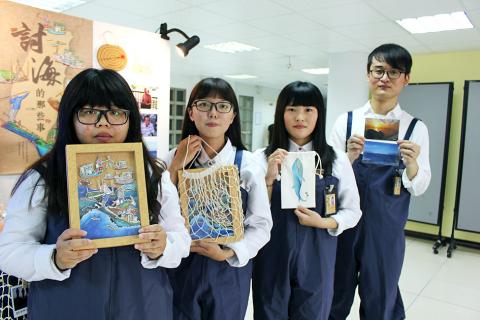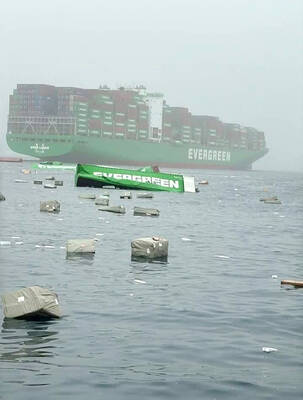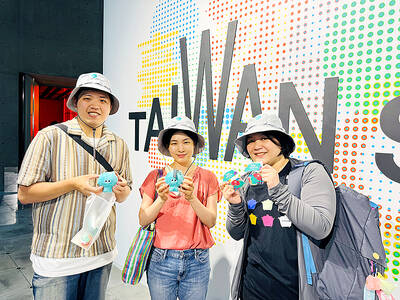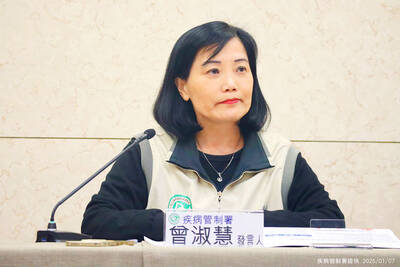Chienkuo University of Science and Technology students are showcasing videos featuring five fishing techniques used across Taiwan in the hope of preserving methods that are dying out.
The students traveled the nation to document the huanghuo (磺火) method used in New Taipei City’s Jinshan District (金山), the sanjiaohu (三腳虎) method used in Yilan County’s Nanfangao (南方澳) port, the ciangu (牽罟) method used in Yilan County’s Toucheng Township (頭城), the diaozeng (吊罾) method used in Tainan’s Sicao District (四草) and swordfish harpooning used in Taitung’s Chenggung Township (成功).
The huanghuo fishing method uses calcium carbide to fuel the flames, while the sanjiaohu uses lighting equipment, students said, adding that both methods use light to attract the fish before they are encircled with nets.

Photo: Chang Tsung-chiu, Taipei Times
The ciangu method aims to locate schools of fish and force them into an area where fishermen had already spread out fishing nets, they said.
The diaozeng method also involves the use of nets, where a net is attached to a bamboo boom jutting out from a boat, allowing the net to be lowered into the water, the students said.
The students recorded the activities to showcase the local fishing methods, the group’s instructor Tu Ya-wen (杜雅雯) said.
The students interviewed fishermen and recorded the interviews on video, Tu said, adding that they also made several items from the materials used in fishing.
The items include hemp-rope book bags that look like fishing nets, mobile-phone cases with colored fish pictures, postcards with quotes from fishing boat captains the students interviewed, name cards that look like sailor permits and stickers, the students said.
Yen Hui-ting (顏慧庭), one of the students, said they were afraid that the fishing boat captains, who are stereotyped as gruff people, would refuse their interview requests.
“However, the captains treated us like their own children,” Yen said, adding: “It was perhaps due to the time spent away from their own families.”
Yen said that she and her friends thought that fishing was only about casting nets and waiting, adding that thanks to the interviews they learned it was more than that, and the fishermen had to think to outsmart the fish they were trying to catch.
Lin Fang-ying (林芳瑩) and Wu Chia-hui (吳家慧), two other students in the group, said the interviews showed them how Taiwan’s fishery resources were drying up.
Tsai Po-kai (蔡博凱), the only male student in the group, said that with the gradual replacement of open-sea fishing with aquaculture industries and the oppression of fishermen by large companies, many of the fishing methods they have documented were in danger of dying out.

The Executive Yuan yesterday approved a southwestern extension of the Sanying MRT Line from New Taipei to Bade District (八德) in Taoyuan, with a goal of starting construction by late 2026. The 4.03-kilometer extension, featuring three new stations, will run from the current terminus at Yingtao Fude Station (LB12) in New Taipei City to Dannan Station (LB14), where it will connect with Taoyuan’s Green Line, New Taipei City Metro Corp said in a statement. This extension will follow the completion of core Sanying Line, a 14.29-kilometer medium-capacity system linking Tucheng (土城), Sansia (三峽)

CARGO LOSS: About 50 containers at the stern of the ‘Ever Lunar’ cargo ship went overboard, prompting the temporary closure of the port and disrupting operations Evergreen Marine Corp, Taiwan’s largest container shipper, yesterday said that all crew members aboard the Ever Lunar (長月) were safe after dozens of containers fell overboard off the coast of Peru the previous day. The incident occurred at 9:40am on Friday as the Ever Lunar was anchored and waiting to enter the Port of Callao when it suddenly experienced severe rolling, Evergreen said in a statement. The rolling, which caused the containers to fall, might have been caused by factors including a tsunami triggered by an earthquake in Russia, poor winter sea conditions in South America or a sudden influx of waves,

The Ministry of Culture yesterday officially launched the “We TAIWAN” cultural program on Osaka’s Nakanoshima sandbank, with the program’s mascot receiving overwhelming popularity. The cultural program, which runs from Aug. 2 to 20, was designed to partner with and capitalize on the 2025 World Expo that is being held in Osaka, Japan, from April 13 to Oct. 13, the ministry said. On the first day of the cultural program, its mascot, a green creature named “a-We,” proved to be extremely popular, as its merch was immediately in high demand. Long lines formed yesterday for the opening

BE CAREFUL: The virus rarely causes severe illness or death, but newborns, older people and those with medical conditions are at risk of more severe illness As more than 7,000 cases of chikungunya fever have been reported in China’s Guangdong Province this year, including 2,892 new cases last week, the Centers for Disease Control (CDC) yesterday said it is monitoring the situation and considering raising the travel notice level, which might be announced today. The CDC issued a level 1 travel notice, or “watch,” for Guangdong Province on July 22, citing an outbreak in Foshan, a manufacturing hub in the south of the province, that was reported early last month. Between July 27 and Saturday, the province reported 2,892 new cases of chikungunya, reaching a total of 7,716